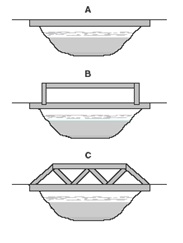In this section, we take a comprehensive look at the structures and properties of materials. Along with principles of mechanics and mechanical devices, this completes the ASVAB test syllabus for this subject.
Posted in 2nd December, 2014 | Mechanical ComprehensionStructures and Properties of Materials

Structures and Properties of Materials


Many of the questions above concerned the concept of load, and this concept is further examined in other ASVAB Mechanical Comprehension questions. You might be asked, for instance, to determine the point of greatest strength or weakness in a particular structure when a load is applied to that structure. For example, many questions look at beams or bridges, and ask you to figure out which bridge would be strongest depending on its foundation and expected load. This is actually much easier than you otherwise would have thought – take a look at the diagram below where we look at the different types of bridges and find out where the stress is loaded.
You should note two things in this regard. The first being the effect from compression and tension; compression is the force experienced when two or more materials are pushed together – in contrast, tension is the force that pulls materials apart. Once you maintain a balance, or equilibrium between the tension and compression forces, you can design a more stable bridge. If we take a look at the bridge types above, we can see how the tension is distributed along the trusses of B and C, whereas this lacks in A. Further, the tension is additionally reinforced by the presence of triangles in C, meaning it can take more compression across the entirety of the bridge. Generally speaking, the more triangular formations a bridge has, the more stable the bridge will happen to be.

Materials Science
he architectural structure of a given building is, of course, crucial to its successful performance. At the same time, though, we must also acknowledge the materials used in the design of these structures. Different materials possess different properties, and materials are chosen for design based on these properties. In your ASVAB Mechanical Comprehension exam, you will need to have a basic grasp of some of the main type of material properties. If you take a look at the diagram below, you will find all the properties you need to know for the exam, as well as how this manifests in day to day reality.

If you look at ductility, for example, you will notice this is the property of a material that results in the ability to withstand strain, or tension. In other words, a material described as having high ductility is a material able to withstand considerable amounts of tension. On the other side, we have brittle materials – these are materials which are easily broken. The reasons for these differences lie in the individual atomic structures of these materials. Some structures have atoms arranged in a tight-knit arrangement, which confers strength, whereas other structures have less defined atomic arrangements, resulting in looser and more flexible materials.
In the final section, we will take a look back over the most important aspects of this study guide that you need to keep in mind.



